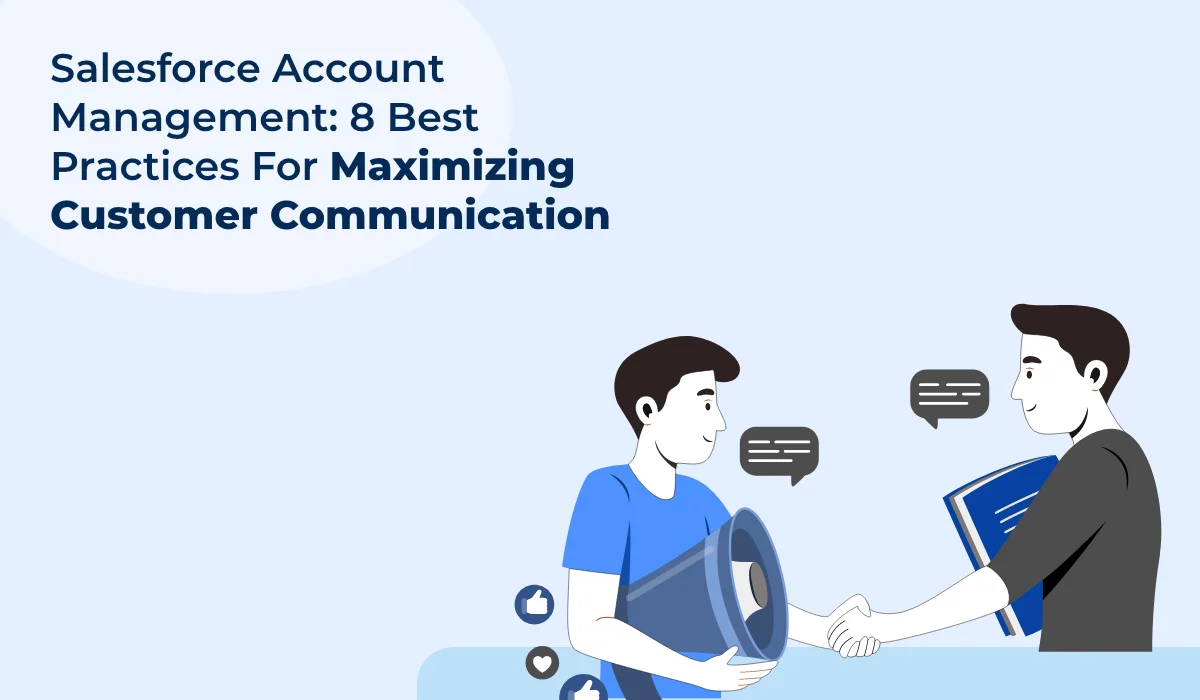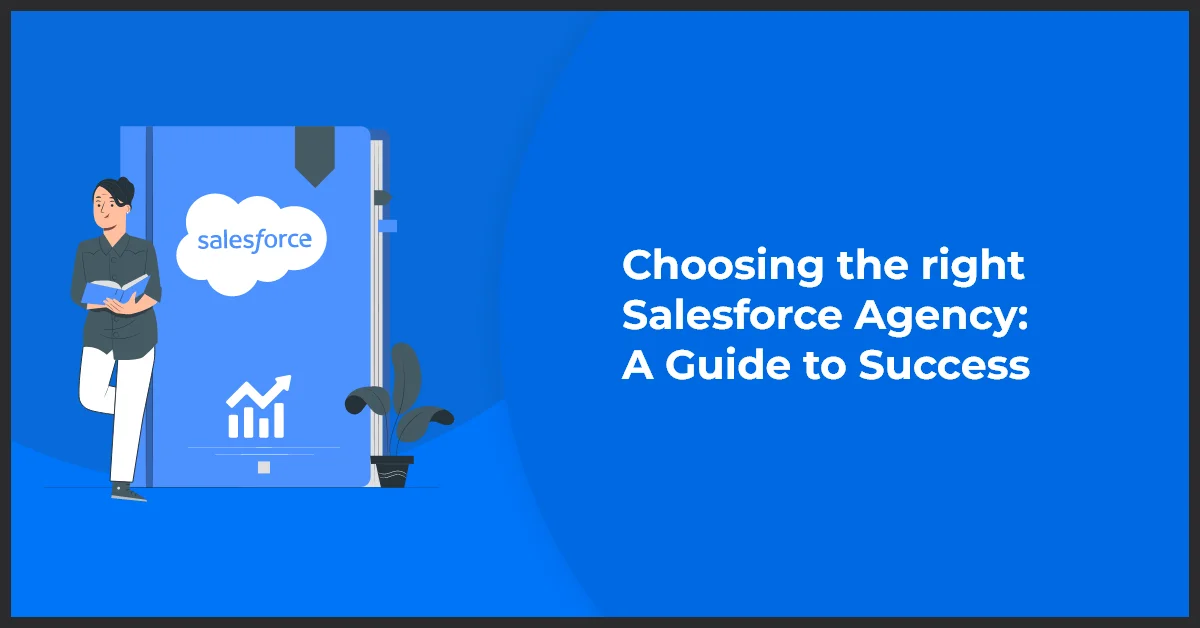8 Best Salesforce Account Management Practices to Boost Customer Communication

Published on: March 27, 2023
Updated on: March 04, 2025
4457 Views
- Salesforce
6 min read
Accounts are a fundamental aspect of the Salesforce data model for many organizations. These accounts can be companies you're already doing business with or potential clients. Maintaining precise account data is essential, as it affects various aspects of business operations, from location details to communication history and sales interactions.
In this blog post, we'll delve into some best practices for effective Salesforce account management and how you can use it to maximize customer communication.
What Is Salesforce Account Management?
At its core, Salesforce is still a customer relationship management tool. And to ensure it is used for more than just sending promotional emails, Salesforce Accounts offer unmatched customizability.
While the default fields cover the basics, like company name, contacts, and billing info, accounts can also be populated with detailed notes on conversations, plans, interests, and potential needs for shared access across the organization.
This centralized account data gives sales and marketing teams a comprehensive view of each customer. With deeper insight, they can build stronger relationships, craft targeted outreach, and maximize customer communication.
Salesforce Account Management: 8 Best Practices
Here are 8 best practices to ensure the data you rely on is accurate, secure, and effectively utilized.
1. Understand Salesforce Accounts and Contacts Relationship
Before delving into account management, it's crucial to understand the relationship between Salesforce Accounts and Contacts. An Account in Salesforce is essentially a business entity you do business with, while Contacts are individuals within that entity with whom you communicate.
In Salesforce, the relationship between Accounts and Contacts combines elements of both lookup and master-detail relationships.
This relationship functions as a lookup relationship in that Contacts can be created independently of Accounts. However, it also has the feature of a master-detail relationship due to the cascade-delete property. When this property is active, and an Account is deleted, any associated Contacts are also deleted.
While Contacts can exist without being linked to an Account (like in a lookup relationship), their deletion upon removing their associated Account mimics the dependency seen in a master-detail relationship. This hybrid approach allows flexibility in managing Contacts while ensuring data integrity when Accounts are removed.
2. Reassign Accounts from Inactive Users
Accounts can remain under the ownership of inactive users, posing a challenge in data management. To prevent any oversight, reassign all Accounts from inactive users to those active in your team.
3. Establish Guidelines and Enforce Data Standards
In Salesforce, data entry and management are pivotal in achieving business objectives, ranging from comprehensive reporting and sales tracking to understanding customer demographics. The foundation of accurate data lies in establishing clear rules and standards.
Allowing users extensive freedom in data entry, especially through open text fields, can hinder consistent reporting and reliability of account data. Salesforce offers a variety of field types to aid in data standardization, such as picklists, phone number fields, and postal code fields. Identifying opportunities for standardization and enforcing them through Salesforce tools like validation rules is key.
Assistance from a Salesforce implementation partner, such as Growth Natives, can be invaluable in this process.
4. Develop Comprehensive Account Records
Salesforce includes standard fields in account records, but additional customization might be necessary to meet specific organizational needs. This could involve creating various account types, custom fields, or custom-related objects and organizing pages for streamlined data entry.
A thorough approach to creating account records involves entering essential information like the account name, industry, employee count, and other relevant details. Incomplete records can lead to data duplication and underutilization of Salesforce's account management features.
Implementing validation rules and field requirements helps promote thorough data entry, but balancing these against potential user frustration from excessive error messages and requirements is important.
5. Utilize Parent-Child Account Relationships
Consider a scenario where your organization interacts with a large multinational corporation with global offices. Understanding existing relationships and business engagements with other offices of the same corporation is crucial.
Salesforce's account hierarchy management feature can illuminate how different accounts are interrelated, allowing you to track divisions, subsidiaries, and business units. This insight is valuable for understanding the influence of various locations and can help uncover new sales opportunities and strengthen relationships within the company.
6. Implement Efficient Automation
Automation in Salesforce can greatly enhance account management. This includes:
- Using Salesforce's lead conversion process to generate accounts and contacts automatically.
- Employing features like Automated Account Fields and Account Logos for easier account creation and review.
- Using tools for importing account data to minimize manual entry depends on the situation.
These are just a few examples of how automation can streamline account management processes.
7. Manage Duplicates Effectively
Even with strict rules and standards, duplicate accounts can still occur. Salesforce's duplicate and matching rules help identify potential duplicates based on specific criteria and dictate how to manage them. These tools can prevent or warn users about creating duplicates and include components on account record pages for easy identification and merging of duplicates.
8. Set Up Account Data Security Protocols
Different team members might need to interact with various customers or prospects. For instance, a sales team might have multiple members engaging with a single customer. Some team members might oversee specific territories, while others collaborate across teams. Salesforce features like Account Teams and Territory Management can facilitate appropriate account access.
Account Teams allow controlled access to certain accounts for specific team members with varying permission levels. Utilize Territory Management to grant account access based on particular account attributes, enhancing efficiency and security in data access.
Top 5 Benefits of Salesforce Account Management
Here are the key benefits of Salesforce account management:
- Streamlined CRM: Centralizes customer data and interactions for easy relationship management.
- Enhanced automation: Automates repetitive sales and marketing tasks to improve productivity.
- Improved lead generation: Identifies and qualifies high-quality leads to maximize sales opportunities.
- Effective segmentation: Segments customers based on various criteria to tailor marketing efforts.
- Growth from customization: Drives business growth by delivering tailored customer experiences.
Conclusion
Effective account management is at the core of building and maintaining strong customer relationships in the Salesforce ecosystem. A seamless and strategic approach to account management not only facilitates smooth communication but also maximizes customer engagement.
Maximizing customer communication through Salesforce account management involves harnessing the platform's capabilities to create a personalized, efficient, and integrated approach. By adopting these practices, businesses can not only meet customer expectations but exceed them, building lasting and fruitful relationships.
Want to Maximize Your Salesforce Investment? Talk to Us!
Our Salesforce-certified experts would love to be part of your Salesforce journey. Just write to us at info@growthnatives.com and we’ll get back to you.
Frequently Asked Questions
Effective customer communication is important in Salesforce Account Management because it builds trust, fosters strong relationships, addresses customer needs, and ultimately leads to customer retention and loyalty.
Salesforce Account Management helps improve customer communication by centralizing customer data, enabling timely and personalized interactions, automating routine tasks, facilitating collaboration among team members, and providing insights into customer preferences and behavior.
Using omnichannel communication channels in Account Management ensures that customers can communicate with their account managers through their preferred channels, whether it’s email, phone, chat, social media, or in-person meetings, providing a seamless and consistent experience.
Personalization in customer communication in Salesforce Account Management involves tailoring messages and interactions to each customer’s preferences, needs, and past interactions, enhancing engagement and relationship-building.



